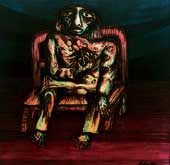 |
| Rabin Mondal?s painting Man Acting as King executed in 1982 from the book |
Rabin Mondal is not made of the same stuff that the habitues of Page Three are. He is neither suave nor media-savvy. He does not attend openings of shops, blood donation camps or exhibitions. He is not exactly photogenic. Even his paintings are not very pleasant to the eye.
Yet he has achieved what many better-known and more visible artists would die for. He has a well-produced, lavishly-illustrated book to his name.
The book, After The Fall, Time, Life & Art of Rabin Mondal, was published by Delhi Art Gallery, his current patron, the same that recently organised a rather good exhibition of the artist who spent the better part of his life in Howrah.
The book has many, many (difficult to keep count of them) reproductions of his paintings and drawings, covering his rather long career.
The text is by veteran Delhi-based art critic Santo Datta. He traces the origins of the Mondal family and tries to build up the social milieu of Howrah, which undoubtedly contributed to Mondal?s dark, unrelenting vision. At times, the quotes from this and that may be a bit too much but the text gives a fairly good idea of the struggle that Mondal must have undergone to establish himself as an artist.
Mondal is not really a fully trained artist ? his family could not afford the fee and this is reflected in the tortured bodies, like souls in Purgatory.
But comparisons between Mondal?s paintings of brothels and skeletal forms and Bat tala literature and Kalighat pats are rather far-fetched. Where is the point of convergence, unless it is the undraped bodies the author means?
Mondal paints from a different mentality altogether. The other point is, was there really an exhibition of contemporary masters of the West in Calcutta in 1948? No one seems to have heard of it.
What makes this book valuable to students of art history is that it has reproduced verbatim many rare documents connected with art movements in Calcutta. The black-and-white photographs of the artist at home in Howrah add to the beauty of the book, although at times the text may seem flimsy.











